Introduction: The Cult of the Triple-Headed Snake
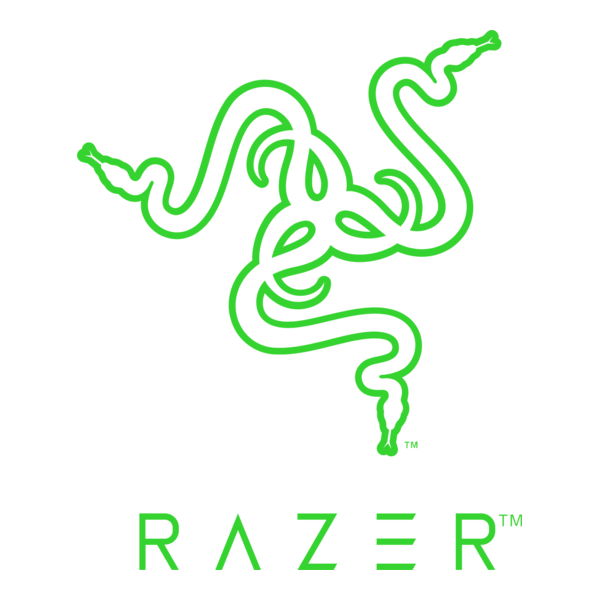
Walk the floor of any major gaming convention, from E3 to Gamescom, and you will be immersed in a sea of light and sound. Amidst the cacophony, one symbol appears with relentless frequency: a neon green, triple-headed snake. It glows from the earcups of headsets, pulses on the surface of mice, and is emblazoned across the chests of esports athletes and devoted fans alike. This is the mark of Razer, and its ubiquity is a testament to a brand that has transcended mere hardware manufacturing to become a cultural phenomenon. For millions, this logo is not just a brand; it is a tribal sigil, a declaration of allegiance to a global community built around the pursuit of digital victory. It represents a lifestyle, an identity, and an unwavering commitment to the world of gaming.
This article will chart the definitive history of Razer, a company that began with a single, revolutionary idea in the nascent days of competitive PC gaming and grew into a global, billion-dollar lifestyle empire. We will deconstruct the meticulously crafted “hype” that fuels its fandom, analyze the iconic hardware that has armed a generation of gamers, and reveal the strategic vision that propelled Razer to the apex of the industry. From a game-changing mouse born in the late ’90s to its current position at the vanguard of AI and sustainability in gaming, this is the story of how Razer forever changed the way we play.
I. The Genesis: How One Mouse Birthed a Billion-Dollar Industry
The Pre-Razer World (Late 1990s)

To understand Razer’s impact, one must first recall the primitive landscape of PC gaming in the late 1990s. This was a revolutionary era, with titles like Quake and Unreal Tournament pioneering fast-paced, multiplayer first-person shooter (FPS) combat. Gamers were pushing the boundaries of skill and reaction time, but their equipment was holding them back. The primary tool of interaction, the computer mouse, was an afterthought—a beige, clunky peripheral designed for navigating office spreadsheets, not for landing precision headshots. These devices were universally limited by low-precision ball mechanics or early optical sensors that topped out at a paltry 400 to 800 Dots Per Inch (DPI), a measure of sensitivity. For the burgeoning class of competitive gamers, this technological ceiling was a source of immense frustration, creating a clear and profoundly unmet need for specialized, high-performance hardware. The market for gaming peripherals didn’t exist yet, but the demand was simmering just below the surface.
The Founding Vision
Into this void stepped two individuals who shared a deep passion not just for playing games, but for winning them: Min-Liang Tan, a Singaporean law graduate, and Robert “RazerGuy” Krakoff, an American marketing professional. They were hardcore gamers who understood that the gap between player skill and in-game performance was being artificially constrained by inadequate tools. Their vision was simple but radical: to create peripherals designed from the ground up with a single purpose—to give gamers a competitive edge. They weren’t looking to build a better office mouse; they were looking to build a weapon.
The Legend of the Boomslang (1999)
This vision first took physical form under kärna LLC, a San Diego-based subsidiary that served as Razer’s precursor. Here, Tan and his small team of engineers and designers created the world’s first dedicated gaming mouse: the Razer Boomslang. The development process itself was revolutionary. Long before “crowdsourcing” became a buzzword, the Boomslang’s design was honed through direct feedback from the very people it was built for. Tan and his team frequented online game servers and forums, sharing prototypes and gathering insights from fellow clan members and competitive players. This made the Boomslang a product that was authentically “For Gamers, By Gamers” from its very first iteration.
The ultimate validation of their work came not in a lab, but in the crucible of online competition. As the story goes, during a test session in a game of Quake, Min-Liang Tan’s performance with a Boomslang prototype was so unnaturally precise and dominant that he was summarily kicked from the server by players who accused him of using an “aimbot”—a cheat program that automatically targets opponents. This moment was the team’s epiphany. They had created a piece of hardware so effective that its performance was indistinguishable from cheating. It offered a tangible, legal, and—most importantly—
unfair advantage, the very holy grail that every competitive gamer secretly craved. This anecdote became more than a fun story; it became the foundational myth of the Razer brand, perfectly encapsulating its core value proposition. It translated a technical specification into an emotional promise: Razer gives you the power to dominate.
The technological leap of the Boomslang was staggering. It launched with options for 1000 and later 2000 DPI, shattering the 400-800 DPI ceiling of its contemporaries. This was not an incremental improvement but a paradigm shift in precision and control, establishing DPI as the benchmark for gaming mouse performance for decades to come. Even the name was a statement of intent. The Boomslang, a venomous African tree snake, was chosen because, as Tan noted, “snakes ate mice”. Razer was here to devour the competition. The Boomslang’s arrival did not just capture a piece of the peripheral market; it proved that a multi-billion-dollar market for high-performance gaming gear existed in the first place, waiting to be unlocked.
From Ashes to Empire (2000-2005)
Despite the Boomslang’s cult status and critical acclaim, the path to dominance was not immediate. Kärna LLC faced financial difficulties and was shut down in 2000, leaving the Razer brand dormant. The dream could have ended there, but Tan and Krakoff were relentless. In 2005, after securing the rights to the brand and a significant investment from Hong Kong tycoon Li Ka-shing and Singapore’s Temasek Holdings, they officially founded the modern Razer Inc..
This relaunch was supercharged by the release of two new mice personally designed by Tan: the Razer Diamondback and the Razer Copperhead. Their commercial success was a resounding validation of the company’s core philosophy. The board of directors, now convinced that the company’s vision should be driven by an actual gamer, installed Tan as the head of the company. This decision cemented the “For Gamers, By Gamers” ethos into the very structure of the organization, setting the stage for its meteoric rise.
II. Forging the Brand: More Than a Slogan, A Battle Cry

Deconstructing “For Gamers. By Gamers.”
Coined around the company’s 2005 relaunch, the motto “For Gamers. By Gamers.” became far more than a marketing tagline; it was the company’s constitution. This simple phrase dictated every aspect of Razer’s strategy, from product design to community engagement. It was a promise that every piece of hardware and software was conceived and built by people who lived and breathed gaming, ensuring that each product would be something they would personally use in a competitive match. This philosophy created an immediate and powerful sense of authenticity that resonated deeply with a gaming community that was often misunderstood and pandered to by larger, out-of-touch corporations.
This slogan effectively functioned as a social contract between Razer and its customers. It assured gamers that the products were designed with their specific, high-stakes needs in mind. In return, this trust granted Razer the social license to experiment with bold, sometimes risky, designs and to command premium prices. The community was willing to pay more because they believed in the brand’s mission; they weren’t just buying a product from a faceless corporation, but from one of their own. This contract fostered a level of brand loyalty that was remarkably resistant to pure price-based competition from rivals.
The CEO as Chief Evangelist
A key element in building this trust was the unique public persona of CEO Min-Liang Tan. In an industry of buttoned-down executives, Tan cultivated the image of a gamer rockstar. He engaged directly and candidly with fans on social media, shared his personal passion for the latest games, and made his followers feel like they were insiders in the company’s journey. This accessibility was unprecedented. When a fan campaign for a Razer-branded toaster started as an internet joke, Tan engaged with it, challenging them to get one million likes on Facebook. When they succeeded, he committed to putting the toaster into production, a testament to his dedication to the community. This direct line of communication was instrumental in building what many have described as the “cult of Razer,” a fiercely loyal fanbase that saw Tan not as a CEO, but as their leader.
Building a Lifestyle Identity
Razer’s marketing genius was in making its marketing feel like anything but. The company famously grew into a global powerhouse without spending a single dollar on traditional advertising. Instead, it relied on organic, word-of-mouth growth fueled by its deep integration within the gaming world. This strategy of “weaponized authenticity” allowed the brand to become an endemic part of the culture rather than an outside entity trying to sell to it.
This was achieved through several key pillars:
- The Iconic Logo: The triple-headed snake trademark evolved into one of the most recognized symbols in all of gaming and esports. It became a badge of honor, a visual shorthand that instantly identified its bearer as a serious gamer. Fans would even get tattoos of the logo, a level of devotion few brands ever achieve.
- Community Cultivation: Razer actively fostered its community through dedicated forums, a massive social media presence across every major platform, and live events. They didn’t just sell products; they created spaces for gamers to connect, share, and celebrate their passion, making customers feel like they were part of a global movement.
- Esports Integration: As will be explored later, Razer’s early and deep investment in the professional gaming scene was a cornerstone of its brand-building. By sponsoring the world’s best players, they ensured their products were seen on the biggest stages, used by the champions.
Ultimately, this approach meant that when a gamer purchased a Razer product, they were doing more than acquiring a piece of hardware. They were buying into an identity, affirming their place within the global gaming tribe, and equipping themselves with the chosen tools of their heroes.
III. The Arsenal: Razer’s Most Iconic and Best-Selling Products
Razer’s empire was built on a foundation of innovative and category-defining hardware. The company’s product strategy often followed a distinct pattern: first, it would “spearhead” a new market or redefine an existing one with a revolutionary flagship product. Once that beachhead was established, it would “diversify” the product line with numerous variations tailored to specific genres, playstyles, and price points. This approach allowed Razer to capture nearly every niche within the market it had created, effectively boxing out competitors and maximizing its saturation.
The Apex Predator: The Razer DeathAdder (2006-Present)
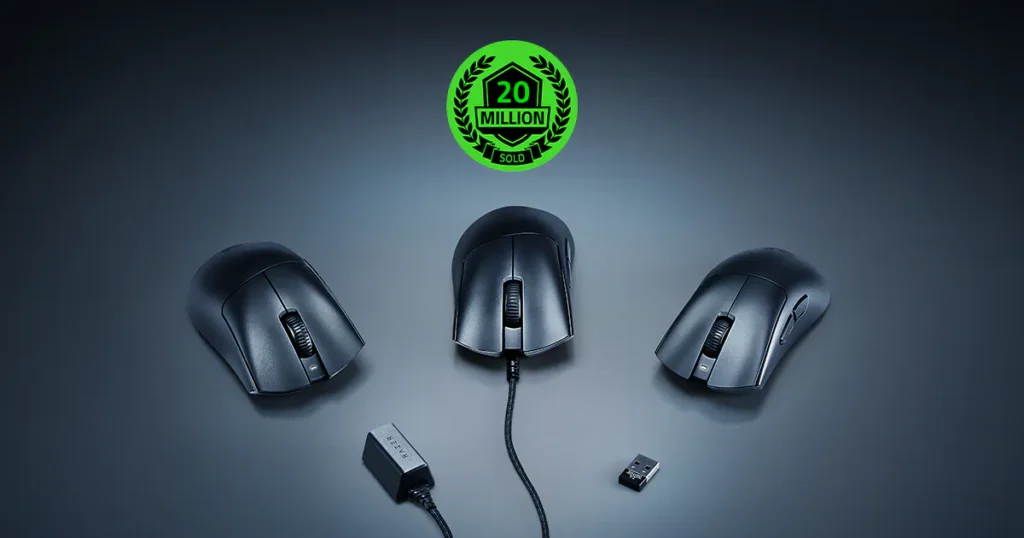
If the Boomslang was the spark, the DeathAdder was the inferno. Launched in 2006, the Razer DeathAdder would become the most renowned and best-selling gaming mouse in history, with over 20 million units sold worldwide as of 2024. Its unprecedented success was not built on flashy gimmicks, but on a relentless focus on fundamentals: “proven durability and ergonomics”. Its classic, right-handed ergonomic form became the gold standard for comfort and control, fitting the hands of millions of gamers like a glove. It was so effective that legendary
League of Legends professional Lee “Faker” Sang-hyeok used a DeathAdder even before he turned pro, later winning three World Championships with the iconic mouse.
The DeathAdder line has been in constant evolution for over a decade, with more than 20 distinct editions released. This evolution showcases Razer’s commitment to both innovation and community feedback. Key milestones include the launch of the Left-Hand Edition in 2010, a costly but important nod to an underserved segment of the community, and the DeathAdder Chroma in 2014, which was the first model to feature the now-ubiquitous customizable RGB lighting.
The Mechanical Revolution: The Razer BlackWidow (2010-Present)
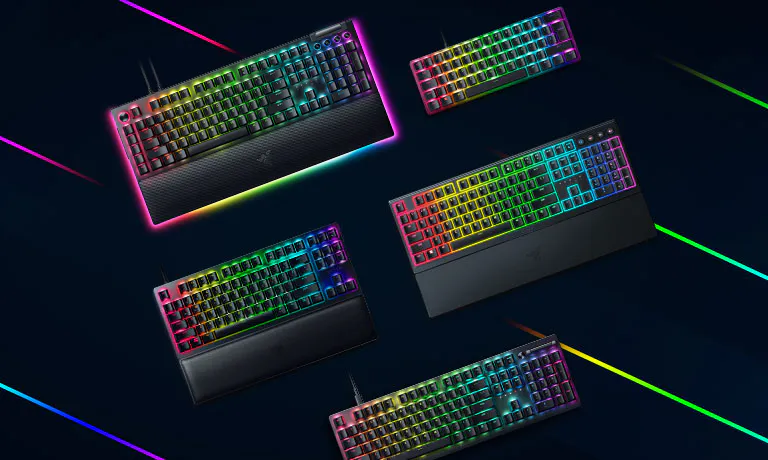
In 2010, Razer unleashed the BlackWidow, its first mechanical gaming keyboard, and in doing so, it almost single-handedly re-popularized mechanical switches for the mainstream gaming market. At a time when most gamers were using cheap, mushy-feeling membrane keyboards, the BlackWidow offered a vastly superior experience. The crisp, tactile feedback and audible click of its mechanical switches provided a level of precision and satisfaction that was a revelation for many players.
As the line matured, Razer took innovation a step further by moving from third-party switches to developing its own. The company engineered proprietary Razer Mechanical Switches designed specifically for the demands of gaming, offering variants like the clicky and tactile Razer Green switches and the linear and silent Razer Yellow switches. This allowed them to fine-tune the actuation points, durability, and feel of their keyboards to perfectly match gamer preferences, further differentiating their products from the competition.
Soundscapes of Victory: The Kraken & BlackShark Headsets
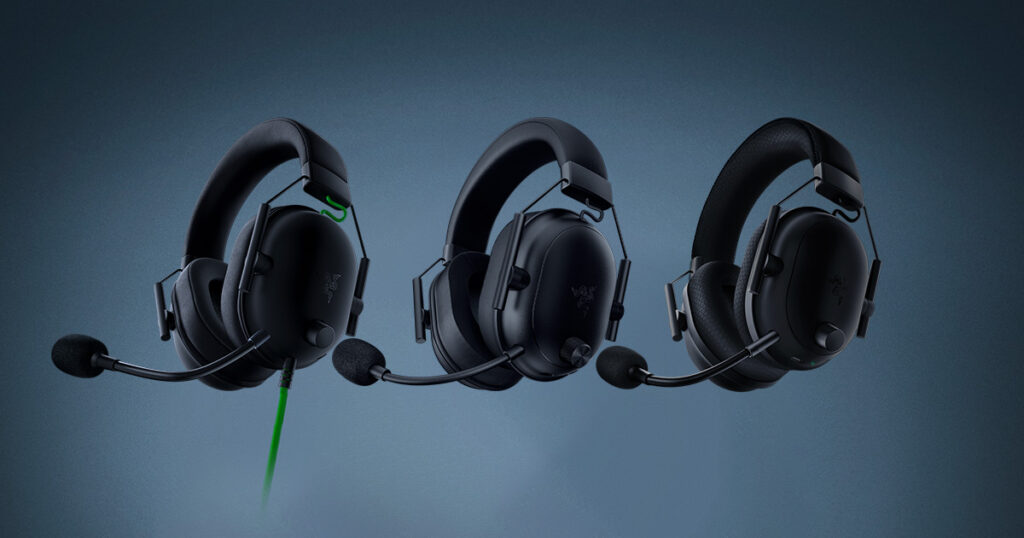
Razer’s foray into audio began in 2006 with the Barracuda headset, the first to offer 5.1-channel surround sound. However, it was the Kraken line that became a true fan favorite. The Kraken was known for its powerful, immersive, and bass-heavy sound profile, perfect for feeling the visceral impact of in-game explosions and epic cinematic moments.
For the competitive scene, Razer engineered the BlackShark series. Where the Kraken focused on immersion, the BlackShark was all about tactical advantage. It was designed to provide crystal-clear positional audio, allowing players to pinpoint enemy footsteps and other crucial sound cues with precision. Combined with a high-quality microphone for team communication and a lightweight, comfortable design built for marathon tournament sessions, the BlackShark became a staple for esports professionals and aspiring amateurs alike.
Redefining Portability: The Razer Blade Laptops (2011-Present)
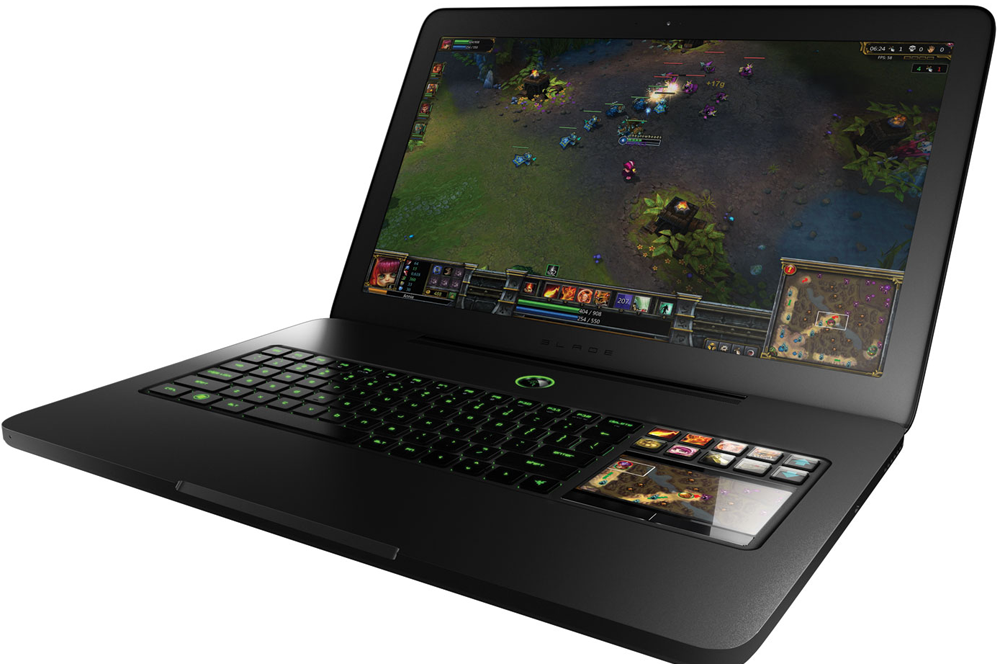
Before 2011, the term “gaming laptop” was almost a misnomer. These devices were typically monstrous, plastic-clad desktop replacements that sacrificed any semblance of portability for raw power. Razer challenged this paradigm with the introduction of the Razer Blade. The first Blade was a marvel of engineering, lauded for its revolutionary design that packed high-performance components into a sleek, durable aluminum chassis that was thinner than a dime. It effectively created and defined the “thin and light” premium gaming laptop category that is now a market standard.
The journey was not without its challenges. Early models were pummeled by critics and fans for their exorbitant price tags and specifications that struggled to keep pace with rapidly advancing desktop hardware. However, Razer was undeterred. Through persistent refinement and a commitment to its design philosophy, the company solidified the Blade’s position as a premium, aspirational product—the “MacBook of gaming laptops”—that remains a benchmark for the industry today.
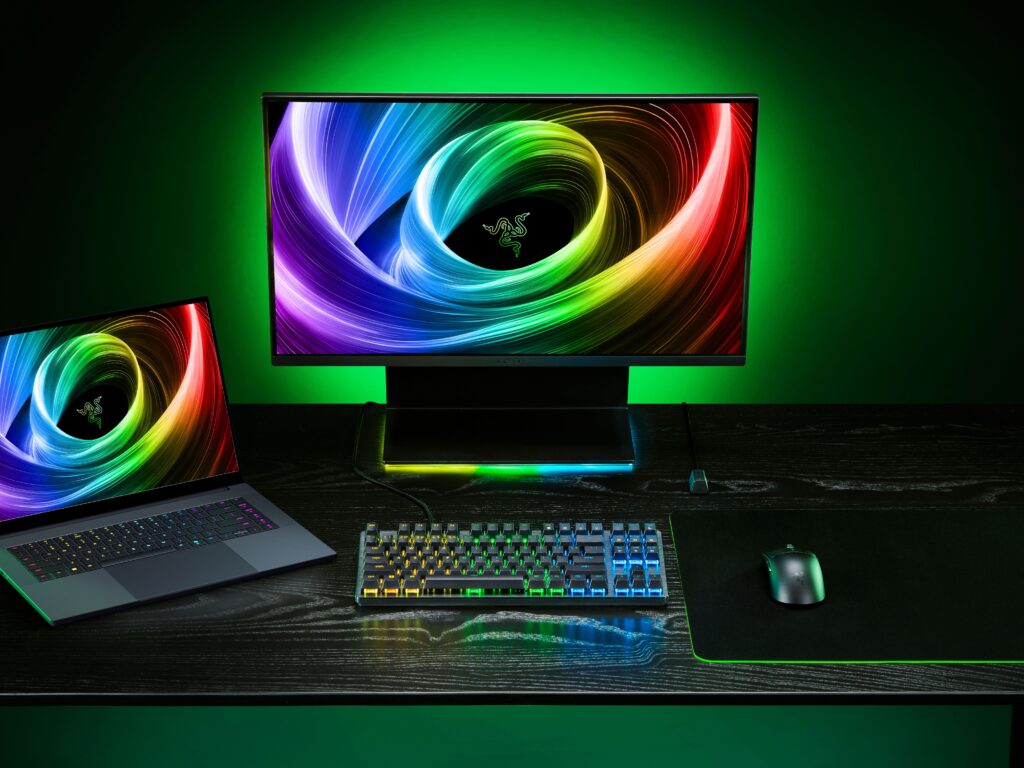
Specialized Weaponry for Every Genre
Following its “diversify” strategy, Razer expanded its mouse lineup to create specialized tools for every type of gamer, ensuring that no matter the genre, there was a perfect Razer mouse for the job.
- Razer Naga: A game-changer for Massively Multiplayer Online (MMO) and Multiplayer Online Battle Arena (MOBA) players, the Naga’s iconic 12-button programmable thumb grid gave players instant access to a vast array of complex spells and macros.
- Razer Viper: Developed in close collaboration with esports pros, the Viper is an ultra-lightweight, ambidextrous mouse built for one thing: speed. Its minimalist design and cutting-edge sensor technology cater to the high-speed, precision-demanding world of competitive FPS gaming.
- Razer Basilisk: Often considered the ultimate FPS mouse, the Basilisk is a highly customizable and ergonomic tool. Its signature features include an adjustable scroll wheel to fine-tune weapon switching and a removable DPI clutch, or “sniper button,” for moments requiring extreme precision.
This deep and varied arsenal ensured that once a player entered the Razer ecosystem, they would find a perfectly tailored weapon for their preferred battlefield.
The Best Razer Gear for Your Playstyle
Choosing the right gear can be daunting. To simplify the process, the following table provides curated loadouts from Razer’s arsenal, optimized for the most common gaming playstyles. This provides actionable advice for gamers seeking to build a setup that best suits their needs, directly reflecting the company’s own strategy of catering to specific niches within the community.
| Playstyle / Genre | Mouse Recommendation | Keyboard Recommendation | Headset Recommendation | Key Features & Rationale |
| Competitive Esports (FPS/Battle Royale) | Razer DeathAdder V4 Pro / Viper V3 Pro | Razer Huntsman V3 Pro Mini (60%) | Razer BlackShark V3 Pro | This loadout prioritizes speed and precision. It features ultra-lightweight mice, high polling rates, optical switches for near-instant actuation, and crystal-clear positional audio for a decisive competitive edge. |
| MMO / MOBA / Strategy | Razer Naga V2 Pro | Razer BlackWidow V4 Pro | Razer Kraken V3 Pro | Built for command and control, this setup maximizes macro capabilities with the Naga’s 12-button thumb grid and the BlackWidow’s dedicated macro keys. Immersive haptic feedback from the Kraken enhances epic in-game moments. |
| Immersive Single-Player / All-Around Gaming | Razer Basilisk V3 Pro | Razer BlackWidow V4 75% | Razer Kraken V4 Pro | A perfectly balanced configuration offering top-tier performance, extensive customization via Chroma RGB and the Basilisk’s adjustable features, and superior comfort for long, immersive gaming marathons. |
| Gaming on the Go / Portable Power | Razer Orochi V2 | N/A | Razer Barracuda Pro | Centered around the powerful and portable Razer Blade 14 laptop, this setup is completed by a compact, long-battery-life wireless mouse and a versatile, multi-platform headset with active noise cancellation for gaming anywhere. |
IV. The Ecosystem: Unifying the Battlestation
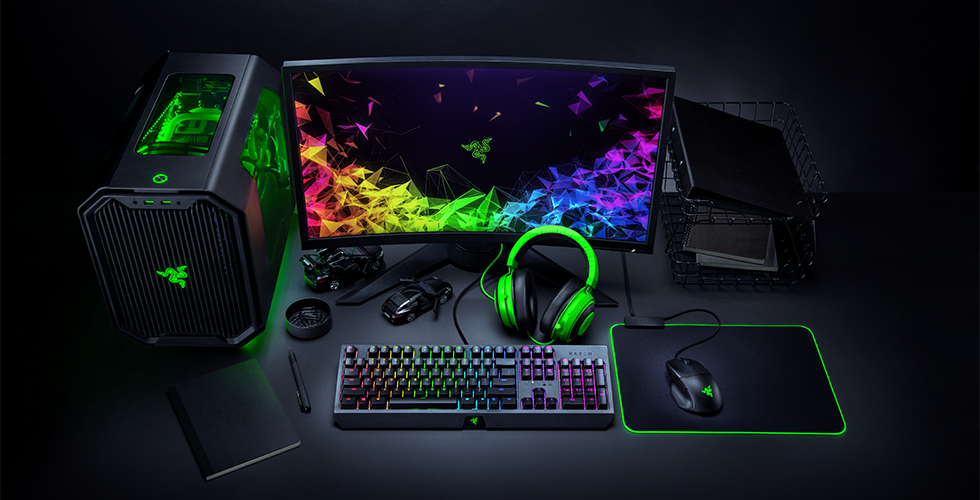
In the hyper-competitive world of PC peripherals, selling excellent individual products is not enough. Competitors can and will replicate features and compete on price. Recognizing this, Razer executed a pivotal strategic shift: moving from selling standalone devices to creating a unified, interconnected ecosystem. This was a deliberate business decision designed to build a powerful competitive “moat”—a set of advantages that are difficult for rivals to overcome—and dramatically increase the lifetime value of each customer.
The Brains of the Operation: Razer Synapse
At the heart of this ecosystem is Razer Synapse, the cloud-based hardware configuration tool that acts as the central nervous system for every Razer device. Synapse is the software that unlocks the full potential of the hardware, allowing users to rebind buttons, assign complex macros, fine-tune sensor sensitivity, and, most importantly, customize lighting effects. A key feature is its cloud integration, which saves a user’s personal settings online, allowing them to access their customized profiles on any computer in the world. While the software has been a cornerstone of the Razer experience for years, it has not been without criticism, with some users historically citing bugs and high resource usage. Acknowledging this, Razer has continued to iterate, recently launching Razer Synapse 4, a ground-up redesign promising a 30% increase in speed and greater system stability.
Painting with Light: The Razer Chroma RGB Revolution
While Synapse provides the control, Razer Chroma RGB provides the soul of the ecosystem. Introduced in 2014 with the DeathAdder Chroma, this technology transformed simple keyboard backlighting into a powerful and dynamic platform for personalization and immersion. With a palette of 16.8 million colors and a suite of advanced effects, Chroma allows users to create stunning visual displays across their entire setup.
The true genius of Chroma, however, lies in its integration. The system can dynamically react to in-game events in a growing list of hundreds of supported titles. Your keyboard might flash red when you take damage in Apex Legends, or your entire room might pulse with color when you unleash an ultimate ability in Overwatch. This elevates RGB lighting from a purely aesthetic feature to an immersive one that enhances gameplay.
Crucially, Razer made the strategic decision to open the Chroma RGB software development kit (SDK) to third-party developers and hardware partners. This masterstroke extended the ecosystem beyond Razer’s own products. Today, over 50 other brands, including Nanoleaf, Govee, Phillips Hue, and Twinkly, have integrated their smart lighting products with Chroma. This allows a gamer to synchronize the lighting of their mouse, keyboard, and headset with the light panels on their wall and the LED strips behind their monitor, creating a single, cohesive, and deeply immersive gaming environment controlled by Razer’s software. This transformed Chroma into the world’s largest lighting ecosystem for gaming devices and built the foundations of Razer’s competitive moat. Once a user has invested in building a multi-device Chroma setup, the aesthetic and functional cost of switching even one component to a competitor’s brand becomes prohibitively high.
Beyond the Desktop: A World of Services and Ventures
Razer’s ambition to own every aspect of the gamer’s lifestyle led to a series of strategic acquisitions and expansions. These ventures were designed to capture revenue streams far beyond the initial hardware sale, transforming physical products into a gateway to a more lucrative digital ecosystem.
- Software and Services: Razer launched Razer Gold, a massive virtual credit and payment service for gamers, allowing them to purchase games and in-game content across thousands of titles. This created a recurring, high-margin revenue stream from its massive hardware user base. This was complemented by Razer Cortex, a free software suite that helps users optimize their PC performance for gaming.
- Hardware Ventures: The company made bold moves into new hardware categories. In 2017, following the acquisition of smartphone startup Nextbit, Razer launched the Razer Phone—the world’s first smartphone designed specifically for gaming, featuring a groundbreaking 120 Hz display. While the product line was ultimately discontinued, it pioneered a new market segment that others would later follow. To bolster its audio credentials, Razer also acquired the legendary audio company THX Ltd., integrating its expertise and certification into future products.
This expansion reveals a long-term strategy mirroring that of tech giants like Apple. The hardware is the entry point, but the ultimate goal is to lock the user into a high-value ecosystem of interconnected software and services.
V. Dominating the Arena: How Razer Conquered Esports
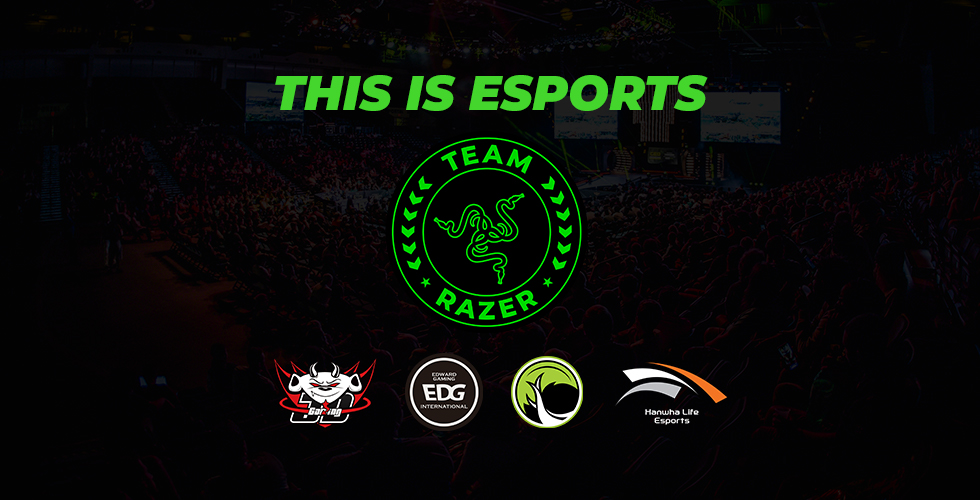
Long before “esports” was a household term and tournament prize pools reached tens of millions of dollars, Razer was there. The company was one of the earliest and most aggressive corporate supporters of competitive gaming, recognizing its potential when most of the world still saw it as a niche hobby. This deep, historical tie to the professional scene became a cornerstone of its brand identity and product development strategy.
Pioneering Sponsorships
Razer’s involvement in esports dates back to the year 2000, when it sponsored the Cyberathlete Professional League (CPL), one of the first major professional gaming tournaments. This was not a bandwagon investment; it was a foundational one. By backing the competitive scene from its infancy, Razer grew alongside it. This co-evolutionary growth created an inseparable link between the Razer brand and the concept of professional gaming in the minds of consumers. While competitors could eventually write checks to sponsor modern teams, they could never retroactively purchase the two decades of shared history and grassroots authenticity that Razer had built with the esports community.
Team Razer: A Symbiotic Feedback Loop
Razer’s sponsorship strategy was far more sophisticated than simply placing a logo on a jersey. The company formed “Team Razer,” a global roster of elite, sponsored esports organizations and individual players, including titans of the industry like Team Liquid, 100 Thieves, and Sentinels. This created a crucial, symbiotic relationship that was mutually beneficial. Razer provided the financial backing and top-tier equipment that allowed these teams to compete at the highest level. In return, the professional players became an invaluable, external research and development department for the company.
Pro gamers push hardware to its absolute limits, subjecting it to thousands of hours of intense use under the most demanding conditions imaginable. This real-world stress testing reveals flaws and potential improvements that standard internal quality assurance could never replicate. By providing prototypes to Team Razer athletes and incorporating their direct feedback into the design process, Razer created a powerful development loop. This ensured that its products were not just designed for gamers, but were effectively co-designed by the best gamers in the world. This process guaranteed that new features were genuinely useful for competitive play, not just marketing gimmicks, and that the final products were “tournament-ready” straight out of the box.
Authenticity and Aspiration
The impact of this deep integration on Razer’s brand was profound. By embedding itself in the fabric of the pro scene, Razer cemented its reputation as the authentic choice of champions. When millions of fans tuned in to watch their heroes win The International or a Call of Duty League Major, they saw them doing it with Razer mice, keyboards, and headsets. This created a powerful aspirational effect. Amateur players, eager to emulate their idols and gain any possible competitive edge, flocked to buy the same gear. Razer’s presence legitimized the burgeoning world of esports, and in turn, the explosive growth of esports legitimized Razer as the premier brand in competitive gaming hardware.
VI. The State of the Game: Razer’s Future is Now
After more than two decades of shaping the industry, Razer stands today as a dominant force. The global gaming accessories market is valued at over $10 billion and is projected to grow at a compound annual growth rate (CAGR) of over 10% in the coming years, with Razer and its primary competitor, Logitech, holding a significant combined market share of over 15%. The competitive landscape is fierce, with established rivals like Corsair, known for its strength in the PC builder community, and SteelSeries, a direct competitor in esports-focused peripherals, all vying for supremacy. In this dynamic environment, Razer is not resting on its laurels. Instead, it is executing a bold strategic pivot, looking beyond hardware to define the next era of gaming through intelligence, immersion, and sustainability.
The Next Level of Innovation: The Pivot to AI and Immersion
Razer’s future strategy crystallized in early 2025 with a formal, heavy investment in artificial intelligence, marked by the launch of global AI Centers of Excellence. This move represents a fundamental shift in its business model, moving from selling physical objects to selling intelligence and integrated experiences. This forward-looking strategy aims to embed Razer’s technology directly into the core processes of both playing and creating games, securing its relevance in a future where software and AI will be the primary battlegrounds.
Key initiatives in this domain include:
- Project AVA (Game Co-AI): Unveiled at CES 2025, Game Co-AI is an AI-powered “Gamer Copilot.” This software sits on top of the game client, using vision analysis and telemetry to provide players with real-time coaching, personalized post-game analysis highlighting areas for improvement, and AI-driven guides for complex quests or boss fights. It also offers one-click PC optimization, fine-tuning system settings for maximum performance. This product signals a major move into the player performance software market.
- QA Co-AI: This tool is aimed not at players, but at developers. QA Co-AI is a cloud plug-in that automates the laborious process of quality assurance and bug detection. It can flag animation glitches, physics breaks, and performance drops, automatically generating a ticket with video clips and suggested reproduction steps. Internal tests suggest it can reduce total QA hours by up to 50%, a massive value proposition for game studios of all sizes.
- Razer Sensa HD Haptics: Pushing the boundaries of immersion, Razer is moving beyond simple controller rumble to a new generation of high-definition haptics. Sensa technology enables complex, multi-directional tactile feedback across multiple actuators and devices. The first product to feature this is the Razer Freyja, a gaming cushion that can translate in-game sounds and actions into nuanced physical sensations, transforming the experience of gaming, movies, and music.
Gaming for Good: The #GoGreenWithRazer Initiative

Alongside its technological ambitions, Razer has made a significant corporate commitment to environmental sustainability. The #GoGreenWithRazer initiative is a comprehensive, 10-year roadmap aimed at minimizing the company’s environmental impact. This is not merely a public relations campaign; it is a strategic effort to appeal to a new generation of environmentally conscious consumers, particularly the Gen Z demographic that forms a core part of the gaming market. By building a brand narrative around responsible innovation, Razer is creating a new dimension of brand loyalty that connects with consumers on an ethical level.
The plan’s ambitious goals have been validated by the prestigious Science Based Targets initiative (SBTi) and are aligned with the 1.5°C target of the Paris Climate Accord. Key commitments include :
- Recycled Materials: Restructuring manufacturing to incorporate up to 85% recycled materials in the base models of its core PC peripheral categories: mice, keyboards, and headsets.
- Renewable Energy: Transitioning all corporate offices to 100% clean, renewable energy.
- Emission Reduction: A commitment to a 90% absolute reduction in operational emissions and a 55% intensity reduction in value chain emissions by 2030, from a 2019 baseline.
- Sustainable Packaging: Eliminating plastics from packaging, optimizing package size, and using FSC-certified paper with soy-based ink.
This initiative positions sustainability as a new competitive differentiator, building brand value that goes beyond raw performance metrics and resonating with the values of the next generation of gamers.
Conclusion: The Game is Just Getting Started
Razer’s journey from a single, disruptive idea to a global gaming colossus is a masterclass in brand building and strategic innovation. Its ascent was not accidental but the result of a clear and consistent vision executed with relentless precision. The story began with the revolutionary Boomslang, a mouse that didn’t just compete in a market but created one from scratch, proving that gamers were a passionate and underserved audience deserving of their own high-performance tools.
From this foundation, Razer’s dominance was built upon three unshakeable pillars. First was a commitment to relentless, gamer-focused innovation, which saw the company define and redefine entire product categories with iconic hardware like the DeathAdder mouse, the BlackWidow keyboard, and the Blade laptop. Second was an unparalleled dedication to authentic community building, guided by the “For Gamers. By Gamers.” ethos, which transformed customers into a loyal tribe of evangelists. Finally, a deep and symbiotic relationship with the world of esports ensured that its products were always forged and validated at the highest level of competition, cementing their reputation as the tools of champions.
Today, Razer stands at a new inflection point. Having conquered the world of physical peripherals and built a powerful software ecosystem to unify them, the company is now setting its sights on the next frontier. Its heavy investments in artificial intelligence, advanced haptics, and corporate sustainability signal a bold ambition to shape not just the hardware we play with, but the very intelligence, immersion, and conscience of gaming itself. While Razer has already defined the past two decades of the industry, its vision for the future has never been clearer. For the company with the triple-headed snake, the game is far from over; it is just getting started.